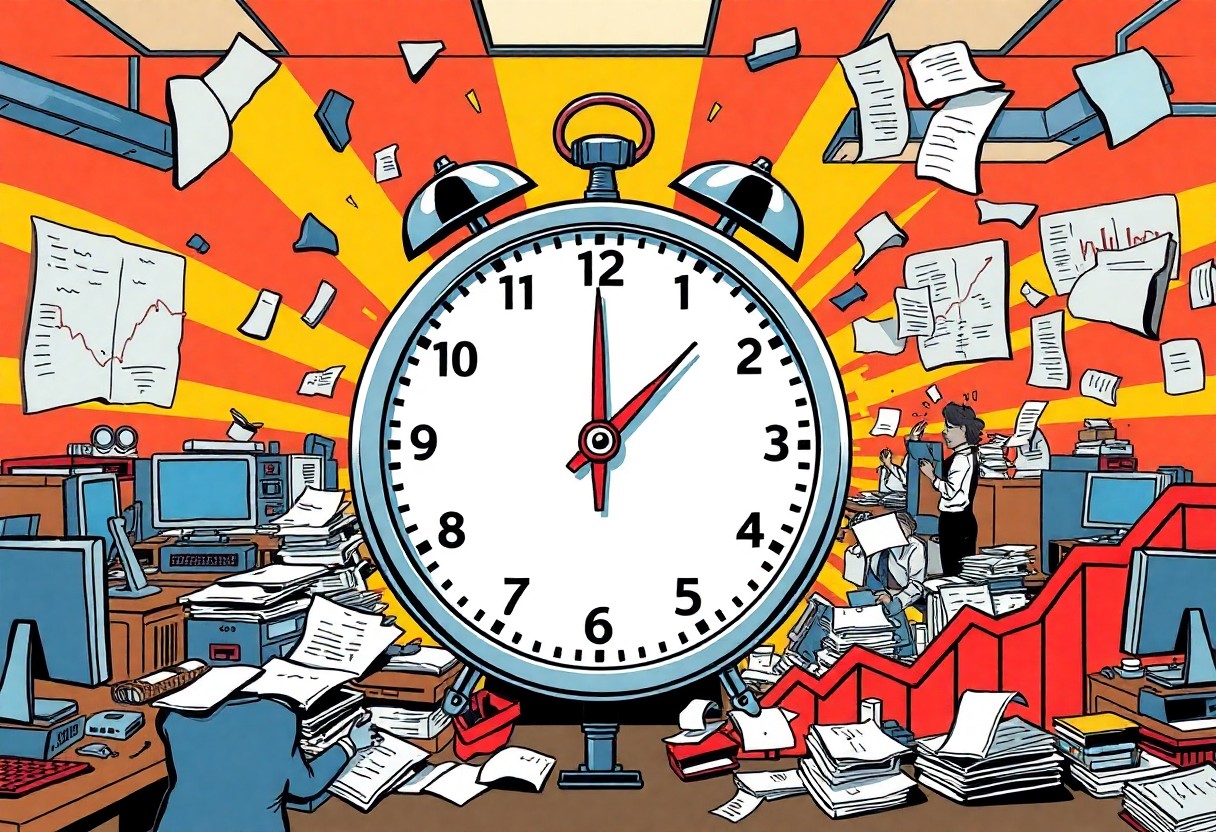The Hidden Costs of Downtime – How Just One Hour Can Cripple Your Business
You may not realize it, but just one hour of downtime can have devastating effects on your business. The financial implications can be staggering, leading to lost revenue, decreased productivity, and potential damage to your reputation. As systems go offline, your employees are unable to work efficiently, and customers lose confidence in your ability to deliver. Understanding the hidden costs associated with downtime is vital for safeguarding your business’s success and planning proactive measures to mitigate risks. Let’s explore deeper into how you can protect your operations and financial stability.
Key Takeaways:
- Downtime can lead to significant financial losses, affecting revenue and productivity—a single hour of downtime can disrupt operations and impact customer satisfaction.
- It’s crucial to have robust contingency plans and proper maintenance protocols in place to minimize the risk of unexpected downtime and its associated costs.
- Investing in reliable technologies and skilled personnel can help prevent downtime incidents and ensure quicker recovery when they do occur, thereby safeguarding business continuity.
The Economic Impact of Lost Hours
Calculating the Financial Toll
Calculating the financial toll of downtime can be straightforward yet alarming. For instance, a 2019 report from the Ponemon Institute revealed that the average cost of IT downtime for businesses is approximately $5,600 per minute. This staggering figure translates into an hourly loss of over $336,000. If you run a business where technology plays a critical role, even just an hour of downtime can lead to severe financial unease. It is not just the direct costs of lost sales; consider wages being paid to employees who are unable to work, alongside the potential costs of losing customers to competitors who can provide uninterrupted service. Each minute your services are unavailable contributes to a swelling deficit that becomes harder to recover from.
The Ripple Effect on Revenue Streams
A single hour of downtime can initiate a ripple effect that touches various revenue streams, ultimately impacting overall business performance. Customers, frustrated by unavailability, could seek out alternatives. Research indicates that more than 60% of consumers will not return to a business that has experienced service interruptions. This churn not only affects current sales but can also have lasting consequences on customer loyalty and brand reputation. Over time, the loss of even a small percentage of your customer base can translate into hundreds of thousands, or even millions, in lost revenue.
This ripple effect extends beyond immediate losses. Every hour you spend offline can interrupt your long-term growth strategies. You may miss vital opportunities for upselling or introducing new products while inoperative. Additionally, employees may experience a drop in morale, leading to lower productivity when operations resume, causing further delays in meeting business objectives. The complex interplay of these factors demonstrates that the economic impact of lost hours is profoundly interconnected and dangerous for businesses of all sizes.
Operational Challenges During Downtime
Experiencing downtime creates a series of operational challenges that ripple throughout your organization, hindering productivity and potentially setting off a chain reaction of complications. As systems go offline, your teams are forced to adapt on the fly, which can lead to confusion, miscommunication, and a decline in overall performance. Projects that were on track suddenly stall, and the resources initially allocated to those projects become tangled in a web of uncertainty. You might find employees re-directed to troubleshooting tasks rather than focusing on their primary responsibilities, causing even more distress.
Resource Allocation and Employee Morale
Resource allocation shifts dramatically during periods of downtime, often leaving your team with limited tools to perform their jobs effectively. With critical systems unavailable, employees might have to juggle multiple roles or resort to using workarounds, which can be counterproductive and frustrating. This improvised approach may lead to a strain on resources, creating an environment where your team feels overwhelmed and unsupported. When employees are sidelined or forced to pivot constantly, their morale can take a significant hit.
As operational expectations collide with the reality of downtime, your employees may experience decreased job satisfaction. The stress of uncompleted work and looming deadlines can foster a sense of anxiety, which can worsen when downtime is prolonged. Lost productivity not only stifles progress but can also discourage your team, diminishing their overall engagement and performance over time. High morale is often correlated with innovation and output; when it suffers, the surrounding workplace atmosphere also deteriorates.
Customer Trust and Satisfaction
Downtime inevitably impacts your customers, shaking the foundation of their trust in your business. When systems fail, response times lag, and customers may feel abandoned, leading to a decline in satisfaction. Your clients expect reliability and consistency, and any disruption might lead them to seek alternative solutions, potentially costing you long-term loyalty. A deterioration in customer relations can manifest as lost sales, negative reviews, and increased churn rates, all of which can jeopardize your competitive edge.
In a survey by Forrester Research, 88% of online consumers reported that they wouldn’t return to a site after a bad experience. Downtime doesn’t just affect current transactions; it shapes the longer-term perception of your brand. If customers find themselves consistently frustrated by outages, your reputation takes a hit, which can extend well beyond immediate losses. This perception translates to fewer sales, as new clients may hesitate to trust a business that they deem unreliable. Damage to customer trust is a lingering fallout, making it imperative to address downtime proactively.
Technological Vulnerabilities Exposed
In today’s hyper-connected world, every business, regardless of size or industry, relies on technology for its operations. However, this reliance also exposes vulnerabilities that can be devastating. From hardware failures to software bugs, the potential for systemic issues is an ever-present reality. For instance, a small glitch in an accounting software system can lead to erroneous billing cycles or delays in payroll, crippling employee trust and productivity. Moreover, when systems that are interlinked experience failures, a ripple effect can magnify the impact of downtime. Even businesses with comprehensive disaster recovery plans might find themselves ill-equipped to handle unexpected technological failures, leading to prolonged outages and increased recovery costs.
Moreover, the rapid pace of technological advancement often leaves businesses with outdated systems that are less resilient. According to a report by the Ponemon Institute, the average cost of unplanned IT downtime in 2020 was approximately $5,600 per minute. This staggering figure further emphasizes the need for timely upgrades and replacements to mitigate such vulnerabilities. Failing to proactively address your technology stack can expose your organization to significant risks, hindering not only recovery efforts but also your overall competitive edge.
Systemic Failures and Recovery Costs
Unforeseen systemic failures can trigger a chain reaction, leading to dire recovery costs that disrupt your daily operations. In the wake of a significant outage, it’s common to face expenses relating to emergency repairs, system replacements, and even potential legal fees if client data is compromised. According to a Cisco study, the average cost of a security breach related to downtime can reach up to $4 million, which includes not only direct recovery costs but also reputational damage. The complexity of recovering lost data and rectifying operational malfunctions can add layers of expenditure that are difficult to quantify but straightforward in their impact on your bottom line.
Furthermore, the time it takes to recover can stretch from hours to weeks, with each passing moment, the operational capabilities of your business being severely diminished. This affects not just internal morale, but also customer loyalty, as delays can lead to lost business opportunities. While your business may have insurance or disaster recovery plans in place, understanding the nuances of these financial burdens places you in a better position to strategize and navigate the aftermath of such untimely disruptions.
The Role of Cybersecurity in Downtime Preparedness
With the increasing number of cyber threats targeting businesses today, a robust cybersecurity strategy serves as a cornerstone in your preparedness for downtime incidents. Employing proactive security measures—such as regular software updates, intrusion detection systems, and employee training on phishing attacks—can significantly reduce your vulnerability to events that might lead to downtime. Furthermore, according to Cybersecurity Ventures, global cybercrime damages are projected to reach $10.5 trillion annually by 2025, underscoring the urgent need for comprehensive cybersecurity defenses that protect against attacks that could lead to crippling outages.
Establishing a multi-layered cybersecurity framework not only safeguards your sensitive data but also fortifies your IT infrastructure against attack vectors that could lead to downtime. Additionally, conducting regular risk assessments can reveal potential weak points in your systems before they lead to expensive disruptions. By prioritizing cybersecurity as an integral part of your downtime preparedness strategy, you are investing not just in your current operational health but also in the sustainable growth of your business.
Proactive Strategies to Mitigate Downtime
Investment in Redundancy and Backup Systems
You might think that having a primary technology setup is enough, but investing in redundancy can save you from catastrophic losses. Consider implementing backup servers, cloud storage solutions, and real-time data replication. Companies like Google and Amazon have set the standard by employing these strategies, offering their clients robust performance even during outages. For example, the 2017 Amazon Web Services outage led to widespread disruptions; however, businesses with backup protocols felt a significantly lesser impact thanks to their preparedness with alternative solutions.
When systems fail, being able to switch seamlessly to a backup can turn potential disaster into a minor inconvenience. Research shows that nearly 80% of businesses that experienced downtime without a plan never recover fully. Investing in these systems can be seen as a form of insurance; sure, you hope you won’t need it, but the consequences of not having it in place can be overwhelming.
Training Employees for a Quick Response
The strength of your workforce often determines the speed of your recovery; thus, training employees to respond swiftly during a downtime scenario can greatly alleviate losses. Developing a comprehensive response plan that includes regular drills ensures that your team knows their roles when emergencies happen. Organizations that simulate downtime scenarios show a reduction in recovery times by up to 50%. This proactive approach allows employees to think critically and make necessary decisions without hesitation.
Your employees are indeed your frontline defense against downtime, which is why instilling a culture of preparedness becomes vital. Consider establishing a cross-departmental team to focus on downtime response strategies, holding workshops that go through your recovery plan thoroughly. Regularly revisiting this training not only enhances employees’ confidence but also creates an environment where they can suggest improvements to existing processes. With well-trained staff and established protocols, your organization will be in a better position to handle unforeseen challenges efficiently and effectively.
The Unseen Effects on Competitive Edge
Market Position and Brand Reputation
Your organization’s market position is intricately tied to how reliable and responsive you are to customer needs. Downtime can severely erode that position, allowing competitors to swoop in and capture your market share. For instance, if your website goes down during a peak shopping hour, this creates a gap where customers can turn to rival companies. You’re not only losing sales during that hour, but you’re also sending a message about your reliability. If customers experience frustration with your brand due to repeated outages, they may choose to permanently switch allegiance, viewing other providers as more dependable.
Brand reputation also takes a hit. Consumers today have endless options and are quick to share negative experiences on social media. A single hour of downtime can lead to hundreds of disgruntled tweets, posts, or reviews. The lasting impact can be exponential, with analysts estimating some brands suffering up to a 20% decline in customer loyalty following significant outages. Protecting your brand is not just about quality products and services; it’s also about ensuring operational stability.
The Long-Term Consequences of Disruption
Disruption from downtime can ripple through your organization in unforeseen ways. Beyond immediate financial losses, the long-term consequences can impair your growth trajectory. Missed opportunities during downtime can create a backlog that impacts project timelines, employee morale, and even product quality. In this way, downtime is akin to a stone thrown into a pond; the initial splash represents immediate losses, but the ripples envelop every part of your business. With timelines derailed and employee focus fractured, your operational efficiency may suffer long after the system is restored.
Recruitment can also become a daunting challenge as potential hires investigate your brand’s performance history. Companies that experience consistent downtime may find themselves struggling to attract top talent, who often seek stability and growth potential in their employers. According to research, organizations that maintain optimal operational uptime are not only more efficient but also see up to 30% higher employee satisfaction and retention rates.
Summing Up
The hidden costs of downtime can severely impact your business in ways you may not have considered. When you experience just one hour of operational disruption, the financial implications can ripple through your organization, affecting everything from productivity to customer satisfaction. You may find that not only does revenue take a hit, but the long-term effects can alter your relationships with clients and damage your brand reputation. It’s necessary to recognize that every minute your systems are down, you’re not just losing money; you’re also losing the trust and loyalty of your customers.
By understanding the comprehensive impact of downtime, you can better prepare and implement strategies that minimize disruption. Invest in reliable technology, train your team on contingency plans, and continuously monitor potential threats to your operations. Taking proactive measures to mitigate downtime can save you from substantial losses and position your business for sustainable growth. Prioritizing uptime is not just a technical necessity; it is a strategic imperative that affects your bottom line, customer relationships, and overall business health.
FAQ
Q1: What are some examples of hidden costs associated with downtime?
A: Hidden costs of downtime can stem from various sources. These include lost revenue due to halted operations, decreased employee productivity as workers may be idled or unable to perform their tasks effectively, and the potential loss of customers if service interruptions become a norm. Additionally, there are costs related to data loss or damage, the need for emergency repairs, and the long-term impact on brand reputation, which can lead to reduced customer loyalty and future sales.
Q2: How can a business prepare for unexpected downtime to minimize its impact?
A: A business can take several proactive steps to prepare for unexpected downtime. This includes developing a comprehensive business continuity and disaster recovery plan that outlines procedures for various scenarios. Regularly leading training sessions for employees on these procedures can ensure everyone knows their roles. Additionally, investing in reliable IT infrastructure, maintaining up-to-date backups, and incorporating redundancy in critical systems can help mitigate the effects of downtime when they occur. Establishing clear communication channels with customers during outages can also improve the situation.
Q3: What are the long-term effects of frequent downtime on a business?
A: Frequent downtime can lead to significant long-term effects on a business, including the erosion of customer trust and satisfaction. Customers may seek alternatives if they experience repeated service interruptions. Furthermore, continuous downtime can stress employee morale and increase turnover rates, as workers may feel frustrated with the working conditions. Financially, the cost of addressing downtime can accumulate, impacting profit margins and operational efficiency. In the competitive landscape, businesses that struggle with consistent downtime risk falling behind their competitors who provide more reliable services.







